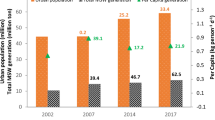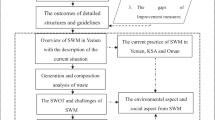Abstract
As one of cities in the developing countries, a rapid population growth and industrial activities pose many environmental challenges for Jimma city, Ethiopia. One aspect of urban growth posing a threat on sustainable development is poor solid waste management, which results in environmental pollution. The purpose of this study is to evaluate the quantity, composition, sources of waste generated, their current disposal practices, and to recommend appropriate management technologies. The total waste generated daily in Jimma city was ca. 88,000 kg, and the average per capita generation rate was 0.55 ± 0.17 kg/capita/day. Eighty-seven percent of the waste was produced by households and 13% by institutions, and a negligible fraction (0.1%) was generated by street sweepings. During the rainy season, 40% more waste was generated than in the dry season because of the increased availability of agricultural food product. Further analysis showed that biodegradable organic waste constitutes 54% by weight with an average moisture content of 60% that falls within the required limits for composting. The nonbiodegradable components constitute 46% of which 30% of it was nonrecyclable material. Only 25% of the community uses municipal containers for disposal at the selected landfill site. Fifty-one percent of the households disposed their waste in individually chosen spots, whereas 22% burned their waste. Finally 2% of households use private waste collectors. The socioeconomic analysis showed that higher family income and educational status is associated more with private or municipal waste collection and less with the application of backyard or open dumping. These insights into generated waste and management practice in Jimma city allow making suggestions for improved collection, treatment, and disposal methods. A primary conclusion is that the biodegradable waste is a major fraction having suitable properties for recycling. As such an economic benefit can be obtained from this waste while avoiding the need for disposal.




Similar content being viewed by others
References
Aarne, P. V., Jeffrey, J. P., & Ruth, F. W. (1994). Environmental engineering (3rd ed.). Boston: Butterworth Heinemann.
Abu-Qdais, H. A. (2007). Techno-economic assessment of municipal solid waste management in Jordan. Waste Management, 27(11), 1666–1672.
Afon, A. O., & Okewole, A. (2007). Estimating the quantity of solid waste generation in Oyo, Nigeria. Waste Management & Research, 25(4), 371–379.
Al-Momani, A. H. (1994). Solid waste management: Sampling, analysis and assessment of household waste in the city of Amman. Environmental Health Research, 4, 208–222.Anschutz, J. (1996). Community-based solid waste management and water supply projects: problems and solutions compared: a survey of the literature. UWEP Nieuwehaven. UWEP Working Document 2.
ASTM. (2000). Standard test methods for moisture, ash, and organic matter of peat and other organic soils. Method D 2974–00. West Conshohocken: American Society for Testing and Materials.
Bandara, N. J. G. J., Hettiaratchi, J. P. A., Wirasinghe, S. C., & Pilapiiya, S. (2007). Relation of waste generation and composition to socio-economic factors: a case study. Environmental Monitoring and Assessment, 135, 31–39.
Bhada-Tata & P., Hoornweg D. (2011). A compilation of global MSW generation rates and composition: projections and policy recommendations. In M. Alamgir, Q. H. Bari, I. M. Rafizul, S. M. T. Islam, G. Sarkar & M. K. Howlader (eds.), Proceedings of the WasteSafe 2011—2nd International Conference on Solid Waste Management in the Developing Countries 13–15 February 2011, Khulna, Bangladesh.
Blume, L. J., Schumacher, B. A., & Shaffer, P. W. (1990). Handbook of methods for acid deposition studies laboratory analyses for soil chemistry. Las Vegas: U.S. Environmental Protection Agency. EPA/600/4-90/023.
Daneil, W. W. (1993). Biostatistics: a foundation for analysis in health sciences (3rd ed.). USA: John Wiley and Sons.
Hockett, D., & Lober, D. J. (1995). Determinants of per capita municipal solid waste generation in the Southeastern United States. Journal of Environmental Management, 45, 205–217.
Imam, A., Mohammed, B., Wilson, D. C., & Cheeseman, C. R. (2008). Solid waste management in Abuja, Nigeria. Waste Management, 28(2), 468–472.
ISWA (2002). Waste management industry as a partner for sustainable development. International solid waste association in collaboration with the United Nations Environmental Program (UNEP).
Jones, A., Nesaratnam, S., Porteous, A. (2008). Factsheet No 2. Factors which influence household waste generation. Department of Design, Development, Environment and Materials Faculty of Mathematics, Computing and Technology the Open University Milton Keynes MK7 6AA.
Kassim, S. M., & Ali, M. (2006). Solid waste collection by the private sector: households perspective; findings from a study in Dar es Salaam city, Tanzania. Habit International, 30(4), 769–780.
Mohd, B. M., Othman, F., Hashim, N., & Ali, N. C. (2002). The role of socio-economic and cultural factors in municipal solid waste generation: a case study in Taman Perling, Johor Bahr. Journal Teknologi, 37, 55–64.
Nelson, D. W., & Sommers, L. E. (1996). Total carbon, organic carbon, and organic matter. In Methods of soil analysis, part 2 (2nd ed.), Agronomy. 9:961–1010. Am. Soc. of Agron., Inc., Madison, WI.
Nguyen, P. T., Yasuhiro, M., & Takeshi, F. (2011). Assessment of plastic waste generation and its potential recycling of household solid waste in Can Tho City, Vietnam. Environmental Monitoring and Assessment, 175, 23–35.
Salequzzaman, M., Awal, S., & Alam, M. (2000). Willingness to pay for community-based solid waste management and its sustainability in Bangladesh. Working paper. Proceedings of the Habitus 2000, Conference in Perty, Aust.
Sharholy, M., Ahmad, K., Mahmood, G., & Trivedi, R. C. (2008). Municipal solid waste management in Indian cities. Waste Management, 28(2), 459–467.
Smith, S. R. (2009). Small-scale home composting of biodegradable household waste: overview of key results from a 3-year research program in West London. Waste Management & Research, 27(10), 941–950.
Sujauddin, M., Huda, S. M. S., & Hoque, R. A. T. M. (2008). Household solid waste characteristics and management in Chittagong, Bangladesh. Waste Management, 28(9), 1688–1695.
Thanh, N. P., Matsui, Y., & Fujiwara, T. (2010). Household solid waste generation and characteristic in a Mekong Delta city, Vietnam. Environmental Management, 91(11), 2307–21.
Tiquia, S. M., Tam, N. F. Y., & Hodgkiss, I. J. (1997). Microbial activities during composting of spent pig-manure sawdust litter at different moisture contents. Environmental Pollution, 98(1), 97–104.
Ulrich, G., Visvanathan, C., & Alamgir, M. (2005). Solid waste management in least developed Asian countries. In International conference on integrated solid waste management in South East Asian cities. Cambodia: Siem Reap.
World Health Organization, (1996). Guides for municipal solid waste management in Pacific countries. Healthy cities-Healthy islands document series, No 6. WHO, Western Pacific Regions. (http://www.wpro.who.int/internet/resources.ashx/EHE/waste_management/Pacificguide.pdf). Accessed 15 Feb 2010.
Acknowledgments
The authors would like to thank the Flemish Institutional University Cooperation and Jimma University partnership program for funding this study and Jimma city administration for cooperating with researchers at the time of data collection.
Author information
Authors and Affiliations
Corresponding author
Rights and permissions
About this article
Cite this article
Getahun, T., Mengistie, E., Haddis, A. et al. Municipal solid waste generation in growing urban areas in Africa: current practices and relation to socioeconomic factors in Jimma, Ethiopia. Environ Monit Assess 184, 6337–6345 (2012). https://doi.org/10.1007/s10661-011-2423-x
Received:
Accepted:
Published:
Issue Date:
DOI: https://doi.org/10.1007/s10661-011-2423-x




